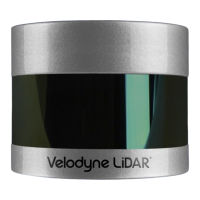1248 bytes/packet * 6253.9 packets/second = 7804867.2 bytes/second
8.2.2 Position Packet Rate
Position packets arrive at approximately 1/14th the rate of data packets.
554 bytes/packet * 1507 packets/second / 14 = 59634 bytes/second
8.2.3 Total Packet Rate
Summing yields 1940370 bytes/second for single return mode.
Dual return mode doubles the data rate but not the position packet rate: (2 * 1880736 bytes/second) + 59634
bytes/second = 3821106 bytes/second
8.2.4 Laser Measurements Per Second
A laser firing results in a single data point, which is a measurement of distance to target and its reflectivity.
32 laser firings/data block * 12 data blocks/packet = 384 laser firings/packet
8.2.4.1 Single Return Mode (Strongest, Last)
384 laser firings/packet * 1507 packets/second = 578688 laser measurements per second
8.2.4.2 Dual Return Mode
384 laser firings/packet * 3014 packets/second = 1157376 laser measurements per second
8.3 Rotation Speed (RPM)
The sensor’s motor can be set to rotate between 300 RPM and 1200 RPM, inclusive, in increments of 60 RPM (e.g. 300,
360, 420, 480, … 1140, 1200).
Note: If the RPM setting is not evenly divisible by 60, neither motor speed control nor phase lock functions will
function properly.
The user can set this parameter using the sensor’s Web Interface or curl commands. See
Configuration Screen on
page 71
or
Sensor Control with curl on page 78
for more on setting rotation speed.
Note: In VeloView, one rotation can be referred to as a single “frame” of data, beginning and ending at approximately 0°
azimuth. The number of frames per second of data generated depends entirely on the RPM setting, e.g. 600 RPM / 60
s/min = 10 frames per second.
Choice of RPM is up to the user and depends on the application. For example, an autonomous vehicle may wish to
increase rotation speed so it could more quickly identify frame-to-frame variations in the environment, such as a child run-
ning across a street. Conversely, a cart-based mapping solution might use a lower RPM to increase the detail in each
frame.
8.3.1 Horizontal Angular (Azimuth) Resolution
Because the firing timing of the sensor is fixed at 55.296 μs per firing sequence, the speed of rotation changes the angular
resolution of the sensor.
An example calculation for 600 RPM is given in
Equation 8-1 on the next page
.
Chapter 8 • Sensor Operation 51

